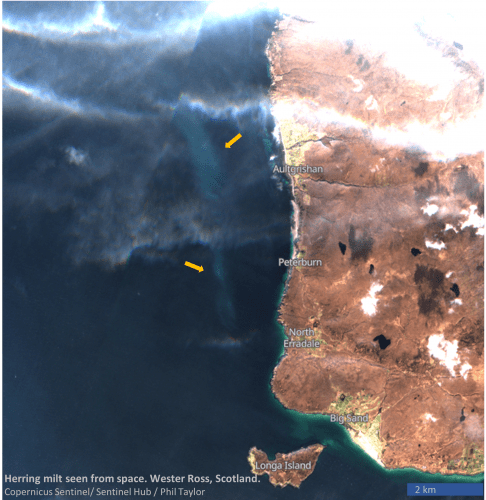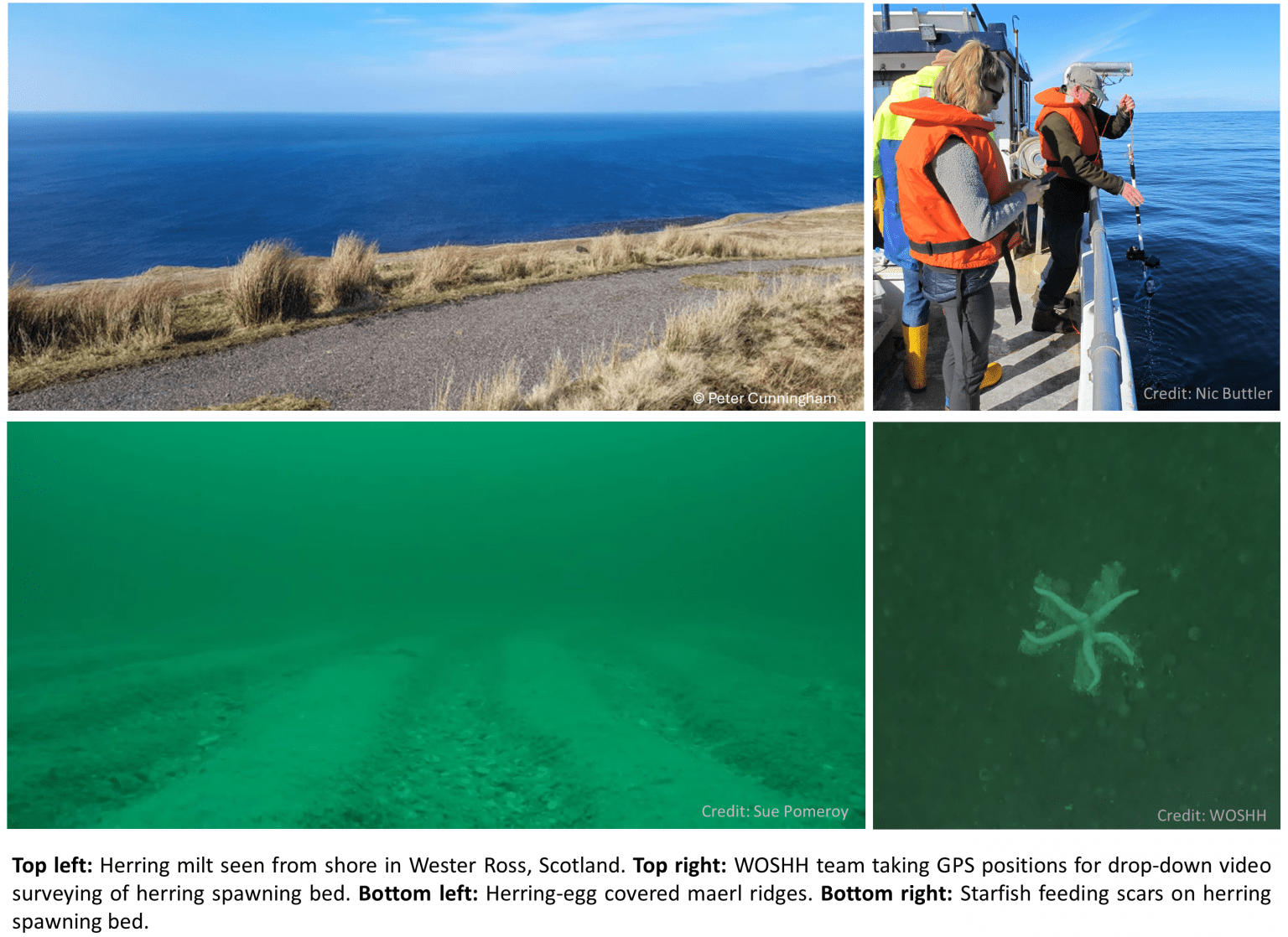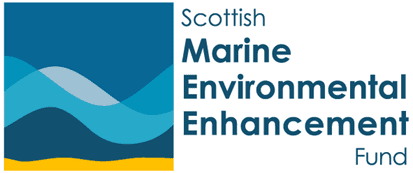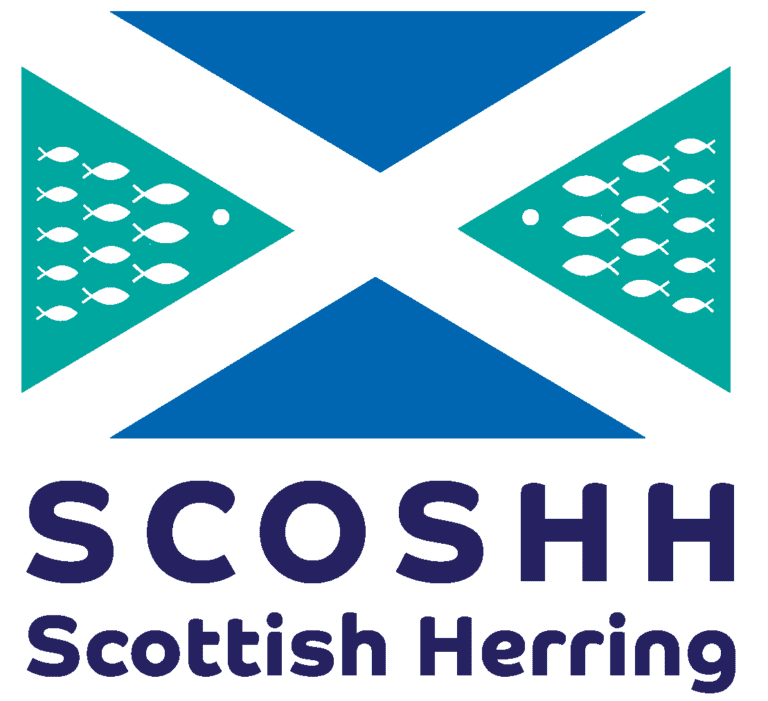West coast herring spawning ground, seen from space, surveyed with local partners
 A West of Scotland herring spawning ground, several kilometers long, has been spotted off the shores of Wester Ross, in an area that was historically considered an important spawning ground (see Frost & Diele 2022).
A West of Scotland herring spawning ground, several kilometers long, has been spotted off the shores of Wester Ross, in an area that was historically considered an important spawning ground (see Frost & Diele 2022).
Since late February, the area has been a hot spot for feeding seabirds and marine mammals, including porpoise, dolphins, orcas, seals and a minke whale (WOSHH also recorded a humpback whale nearby during the herring spawning time last year). These sightings, along with reports of ‘ripe’ herring landed in Ullapool, suggested herring likely spawned or were just about to.
A [rare] sunny day, on the 10th of March, revealed a distinctive cloud of “milky” water, spotted by WOSHH partner, Peter Cunningham, WRFT. The patch of milky water was also seen from the Copernicus Satellite, on the same day, and was likely herring ‘milt’ (sperm), which sinks over the eggs on the seafloor to fertilise them (see Life History). The patch of milky water was at least 6 km long and approximately 700 m wide, and 1.5-2 km from shore. In Canada, the spawning of [Pacific] herring is also visible, each year, from satellite images, and attracts huge amounts of wildlife, feeding on the nutrient-rich eggs and shoals, as well as wildlife tourism to view the spectacle. The wildlife following spawning Atlantic herring shoals in the Minch over the last few weeks is fantastic news for marine biodiversity, productivity and the local community!
Following the discovery of herring milt in the Minch, on the 12th of March a team of local community members, including Peter Cunningham, WRFT, Sue Pomeroy and Fiona Mackenzie of Little Loch Broom Marine Life, Steve Truluck and skipper Ian McWhinney and Jezebel of Shellfish Safaris, with support from WOSHH, used a Remotely Operated Vehicle (ROV) and drop-down camera (an underwater camera mounted on a frame that can be lowered into the water) to look for herring eggs on the seabed. Two herring spawning beds were found, with several layers of eggs on maerl (a coralline red algae) ridges (see here for more details), much to the joy of the team.
The next weather-window permitting the WOSHH team to survey the spawning beds was on the 20th of March. Michelle Frost, WOSHH project coordinator, Peter Cunningham, WRFT, Nic Buttler, WRFT volunteer, Alberto Morales, WOSHH volunteer, Ian McWhinney and Jezebel of Shellfish Safaris surveyed part of the spawning bed, conducting 20 drops using drop-down camera equipment. Simultaneously, environmental DNA samples were collected (to help develop a new herring spawning detection tool). The video footage and plankton sampling to catch herring larvae revealed that large parts of the eggs had survived and hatched. The abundance of small herring larvae, with yolk-sacs still present, was a great sight! The sea will now be bubbling with herring larvae that will spend the spring and summer growing until they metamorphose into juveniles (or whitebait). Use our app to report these sightings!
We will now analyse the video footage, plankton and eDNA samples – watch this space for future updates.
Amazing teamwork by everyone who mobilised so quickly and found those elusive herring eggs and larvae!
A big thank you also to the funders of our West of Scotland Herring Hunt (WOSHH) project (The William Grant Foundation), and the WOSHH-eDNA-Sound project (supported by the Scottish Marine Environmental Enhancement Fund (SMEEF)), whose funding, amongst other, supported Peter Cunningham’s coastal-watching-out-for-herring, the boat trips & crew time. Some videoing equipment was supported by the Scottish Government’s Nature Restoration Fund, managed by NatureScot.





